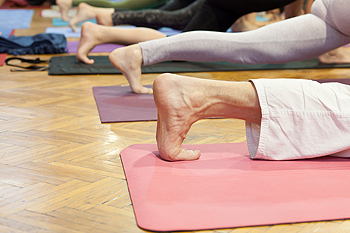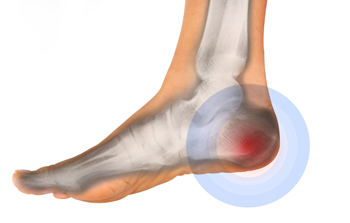Connect With Us
Blog
Items filtered by date: April 2023
Stretches for the Plantar Fascia

The majority of people enjoy stretching their feet. It can produce endorphins, which make the overall body feel good. The feet carry the weight of the body, and they may become stronger when they are frequently stretched. The plantar fascia is a band of tissue found on the sole of the foot, and it connects the heel to the toes. An effective exercise for this band of tissue is done by standing on a step, and lowering one heel at a time until a gentle stretch is felt. Many people roll their foot on a frozen water bottle or tennis ball for several seconds, then repeat on the other foot. Practicing toe scrunches or picking up marbles can be beneficial in strengthening muscles in the entire foot. Toe scrunches are done by placing a towel on the floor and scrunching it with the toes until the foot becomes fatigued. Picking up marbles with the toes and placing them in a cup is a stretching technique that uses similar foot muscles. If you would like additional information about how to stretch your feet, it is suggested that you speak with a podiatrist who can provide you with the knowledge you are seeking.
Why Stretching Is Important for Your Feet
Stretching the feet is a great way to prevent injuries. If you have any concerns with your feet consult with Michael Tomey, DPM from Cary Foot & Ankle Specialists. Our doctor will assess your condition and provide you with quality foot and ankle treatment.
Stretching the Feet
Stretching the muscles in the foot is an important part in any physical activity. Feet that are tight can lead to less flexibility and make you more prone to injury. One of the most common forms of foot pain, plantar fasciitis, can be stretched out to help ease the pain. Stretching can not only ease pain from plantar fasciitis but also prevent it as well. However, it is important to see a podiatrist first to determine if stretching is right for you. Podiatrists can also recommend other ways to stretch your feet. Once you know whether stretching is right for you, here are some excellent stretches you can do.
- Using a foam roller or any cylindrical object (a water bottle or soda can will do), roll the object under your foot back and forth. You should also exert pressure on the object. Be sure to do this to both feet for a minute. Do this exercise three times each.
- Similar to the previous exercise, take a ball, such as a tennis ball, and roll it under your foot while seated and exert pressure on it.
- Grab a resistance band or towel and take a seat. If you are using a towel, fold it length wise. Next put either one between the ball of your foot and heel and pull with both hands on each side towards you. Hold this for 15 seconds and then switch feet. Do this three times for each foot.
- Finally hold your big toe while crossing one leg over the other. Pull the toe towards you and hold for 15 seconds. Once again do this three times per foot.
It is best to go easy when first stretching your foot and work your way up. If your foot starts hurting, stop exercising to ice and rest the foot. It is advised that you then see a podiatrist for help.
If you have any questions, please feel free to contact our office located in Cary, NC . We offer the newest diagnostic and treatment technologies for all your foot care needs.
The Many Types of Heel Pain

The heels of the feet endure a great deal of stress and, therefore, are often open to pain and injury. The most common causes of heel pain are plantar fasciitis, Achilles tendonitis, bone spurs, and stress fractures. Heel bursitis, Sever’s disease, and Haglund’s syndrome are other causes that occur less frequently. Pain can be experienced behind the heel, within the bone itself, and under the heel. Simply stepping on a hard rock can cause pain under the heel, but the most common cause is plantar fasciitis. This is an overuse injury to the tissue that runs under the foot and connects the heel to the toes. Chronic plantar fasciitis can also lead to the development of heel spurs on the calcaneus, the main heel bone. Inflammation to the Achilles tendon from overuse is the most frequent cause of pain behind the heel. A podiatrist, a medical doctor who is trained in ailments of the feet and ankles, can diagnose the cause of heel pain by conducting a number of tests. These may include X-rays and electronic imaging tests. If you are suffering from heel pain and are unsure of the cause, it is suggested that you make an appointment with a podiatrist today.
Many people suffer from bouts of heel pain. For more information, contact Michael Tomey, DPM of Cary Foot & Ankle Specialists. Our doctor can provide the care you need to keep you pain-free and on your feet.
Causes of Heel Pain
Heel pain is often associated with plantar fasciitis. The plantar fascia is a band of tissues that extends along the bottom of the foot. A rip or tear in this ligament can cause inflammation of the tissue.
Achilles tendonitis is another cause of heel pain. Inflammation of the Achilles tendon will cause pain from fractures and muscle tearing. Lack of flexibility is also another symptom.
Heel spurs are another cause of pain. When the tissues of the plantar fascia undergo a great deal of stress, it can lead to ligament separation from the heel bone, causing heel spurs.
Why Might Heel Pain Occur?
- Wearing ill-fitting shoes
- Wearing non-supportive shoes
- Weight change
- Excessive running
Treatments
Heel pain should be treated as soon as possible for immediate results. Keeping your feet in a stress-free environment will help. If you suffer from Achilles tendonitis or plantar fasciitis, applying ice will reduce the swelling. Stretching before an exercise like running will help the muscles. Using all these tips will help make heel pain a condition of the past.
If you have any questions please contact our office located in Cary, NC . We offer the newest diagnostic and treatment technologies for all your foot and ankle needs.
Are You Suffering From Ingrown Toenails?
A Sprained Second Toe

The majority of people that have pain in their second toe have endured an injury. It can happen if a heavy object drops on it, or from accidentally kicking something hard. Pain in this toe may cause difficulty while walking, in addition to affecting balance. The toe can become sprained, and this affects the ligament that connects two or more bones. A toe sprain can happen if the toe is twisted beyond its normal range of motion, or possibly from falling. The symptoms of a sprained second toe can include bruising, swelling, and intense pain. An X-ray can be taken to rule out a fracture, and this can be followed by beginning the correct treatment. This can consist of using the buddy taping method, which is done by taping the sprained toe to the toe next to it. This is generally successful in providing the necessary stability as it heals. If you have pain in your toes, it is suggested that you seek the counsel of a podiatrist who can guide you to the treatment that is best for you.
Toe pain can disrupt your daily activities. If you have any concerns, contact Michael Tomey, DPM of Cary Foot & Ankle Specialists. Our doctor can provide the care you need to keep you pain-free and on your feet.
What Causes Toe Pain?
Most severe toe pain is caused due to a sports injury, trauma from dropping something heavy on the toe, or bumping into something rigid. Other problems can develop over time for various reasons.
Toe pain can be caused by one or more ailments. The most common include:
- Trauma
- Sports injury
- Wearing shoes that are too tight
- Arthritis
- Gout
- Corns and calluses
- Hammertoe
- Bunions
- Blisters
- Ingrown toenails
- Sprains
- Fractures (broken bones)
- Dislocations
When to See a Podiatrist
- Severe pain
- Persistent pain that lasts more than a week
- Signs of infection
- Continued swelling
- Pain that prevents walking
Diagnosis
In many cases the cause of toe pain is obvious, but in others, a podiatrist may want to use more advanced methods to determine the problem. These can range from simple visual inspections and sensation tests to X-rays and MRI scans. Prior medical history, family medical history, and any recent physical traumatic events will all be taken into consideration for a proper diagnosis.
Treatment
Treatments for toe pain and injuries vary and may include shoe inserts, padding, taping, medicines, injections, and in some cases, surgery. If you believe that you have broken a toe, please see a podiatrist as soon as possible.
If you have any questions please feel free to contact our office located in Cary, NC . We offer the newest diagnostic tools and technology to treat your foot and ankle needs.
Should Pregnant Women Wear New Shoes?

When a woman becomes pregnant, her body undergoes significant bodily changes that could negatively impact the health of her feet. During pregnancy, a woman’s feet can increase in size. Many pregnant women will often wonder whether they ought to wear new shoes during their pregnancy to accommodate this increase in the size of their feet. Some women will wear pregnancy shoes to better support their feet as they bring their baby to term. Pregnancy shoes of this kind can minimize pressure and pain. This type of shoe can also combat twists or sprains because it supports the ankle. Some pregnancy shoes are also designed without straps and laces to minimize the extent to which a pregnant woman would have to bend over to adjust the shoes. If you are pregnant or are planning on becoming pregnant, it is suggested that you are under the care of a podiatrist.
Pregnant women with swollen feet can be treated with a variety of different methods that are readily available. For more information about other cures for swollen feet during pregnancy, consult with Michael Tomey, DPM from Cary Foot & Ankle Specialists. Our doctor will attend to all of your foot and ankle needs.
What Foot Problems Can Arise During Pregnancy?
One problem that can occur is overpronation, which occurs when the arch of the foot flattens and tends to roll inward. This can cause pain and discomfort in your heels while you’re walking or even just standing up, trying to support your baby.
Another problem is edema, or swelling in the extremities. This often affects the feet during pregnancy but tends to occur in the later stages.
How Can I Keep My Feet Healthy During Pregnancy?
- Wearing orthotics can provide extra support for the feet and help distribute weight evenly
- Minimize the amount of time spent walking barefoot
- Wear shoes with good arch support
- Wear shoes that allow for good circulation to the feet
- Elevate feet if you experience swelling
- Massage your feet
- Get regular, light exercise, such as walking, to promote blood circulation to the feet
If you have any questions please feel free to contact our office located in Cary, NC . We offer the newest diagnostic and treatment technologies for all your foot and ankle needs.

